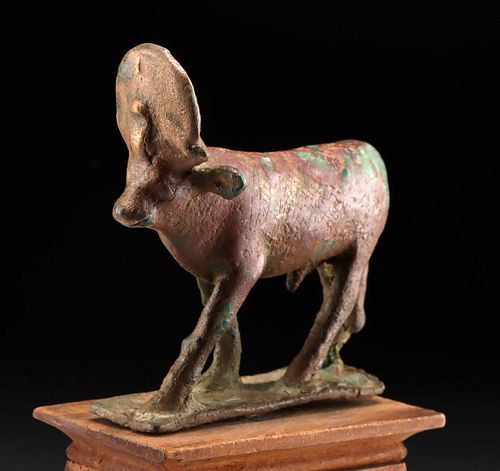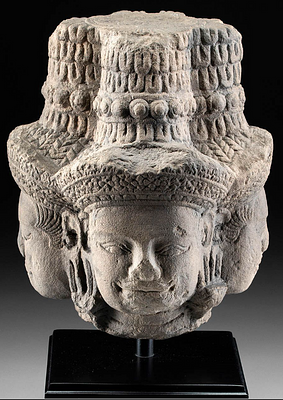Romano-Egyptian Leaded Copper Apis Bull Statue
Lot 3d
About Seller
Artemis Fine Arts
686 S Taylor Ave, Ste 106
Louisville, CO 80027
United States
Selling antiquities, ancient and ethnographic art online since 1993, Artemis Gallery specializes in Classical Antiquities (Egyptian, Greek, Roman, Near Eastern), Asian, Pre-Columbian, African / Tribal / Oceanographic art. Our extensive inventory includes pottery, stone, metal, wood, glass and textil...Read more
Categories
Estimate:
$2,000 - $3,000
Absentee vs Live bid
Two ways to bid:
- Leave a max absentee bid and the platform will bid on your behalf up to your maximum bid during the live auction.
- Bid live during the auction and your bids will be submitted real-time to the auctioneer.
Bid Increments
| Price | Bid Increment |
|---|---|
| $0 | $25 |
| $300 | $50 |
| $1,000 | $100 |
| $2,000 | $250 |
| $5,000 | $500 |
| $10,000 | $1,000 |
| $20,000 | $2,500 |
| $50,000 | $5,000 |
| $100,000 | $10,000 |
| $200,000 | $20,000 |
About Auction
By Artemis Fine Arts
Jun 29, 2023
Set Reminder
2023-06-29 10:00:00
2023-06-29 10:00:00
America/New_York
Bidsquare
Bidsquare : Exceptional Antiquities, Ethnographic and Fine Art
https://www.bidsquare.com/auctions/artemis-gallery/exceptional-antiquities-ethnographic-and-fine-art-13031
Artemis Fine Arts info@artemisfinearts.com
Artemis Fine Arts info@artemisfinearts.com
- Lot Description
Egypt, Late Ptolemaic to Romano-Egyptian Period, ca. 30 BCE to 2nd century CE. A gorgeous cast-leaded copper votive figure representing the sacred Egyptian bull god Apis. He wears a sun disk surrounded by large bull horns - a crown commonly associated with the deities Hathor and Isis - presented with a frontal uraeus, all above almond-shaped eyes and an extended, rounded snout. Apis is shown in stride on four hooved legs atop an integral plinth, his muscular body gradually tapering to a downcast bovine head, with a sinuous tail and delineated genitalia between his back legs. Rich patina envelops the figure, imbuing it with a fabulous archaeological appearance. Size: 2.8" L x 1.2" W x 2.8" H (7.1 cm x 3 cm x 7.1 cm); 4.6" H (11.7 cm) on included custom stand.
Apis was originally worshipped by Narmer, the ruler who unified Upper and Lower Egypt around 3000 BCE - the sacred bull is shown trampling the pharaoh's enemies on the Narmer palette that commemorates the unification. Three thousand years later, by the time of Roman control of Egypt, the worship continued. Though centered around the city of Memphis, the cult of Apis was so extensive in Egypt that the Greeks and Romans wrote about it repeatedly. The famous French archaeologist Mariette, excavating at the Serapeum of Saqqara, found the mummified remains of more than sixty bulls, some buried in their own separate tombs.
Provenance: East Coast collection, New York Gallery, New York City, New York, USA, acquired before 2010
All items legal to buy/sell under U.S. Statute covering cultural patrimony Code 2600, CHAPTER 14, and are guaranteed to be as described or your money back.
A Certificate of Authenticity will accompany all winning bids.
We ship worldwide and handle all shipping in-house for your convenience.
#179494Weathering to surface with expected abrasions, but otherwise intact and excellent with impressive remaining detail and rich patina throughout.Condition
- Shipping Info
-
All shipping is handled in-house for your convenience. Your invoice from Artemis Gallery will include shipping calculation instructions. If in doubt, please inquire BEFORE bidding for estimated shipping costs for individual items.
-
- Buyer's Premium



 EUR
EUR CAD
CAD AUD
AUD GBP
GBP MXN
MXN HKD
HKD CNY
CNY MYR
MYR SEK
SEK SGD
SGD CHF
CHF THB
THB














